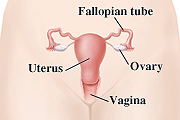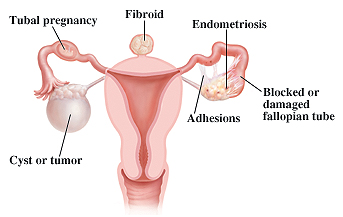Reasons for Pelvic Laparoscopy
Pelvic laparoscopy lets your healthcare provider directly view the reproductive organs. They can see what’s causing problems. Problems may include pain, bleeding, abnormal growths, or trouble getting pregnant. Treatment may happen as part of the same procedure. It will depend on the cause of the problem. You'll discuss this with your healthcare provider before the procedure. Conditions often diagnosed and treated by laparoscopy are shown below.


-
Tubal pregnancy. This occurs when an embryo implants in a fallopian tube. Untreated, the tube can burst (rupture) and bleed.
-
A fibroid (lump of uterine muscle tissue). This can cause pain, bleeding, and problems during pregnancy. It can also cause trouble getting pregnant.
-
Endometriosis (growth of uterine lining tissue outside the uterus). This can lead to pain, bleeding, and trouble getting pregnant.
-
A cyst (fluid-filled sac) or tumor (abnormal growth). These can form on the ovary or fallopian tube. They can cause pain and other health problems.
-
Adhesions (scar tissue). These can cause pain and trouble getting pregnant.
-
A blocked or damaged fallopian tube. This can cause trouble getting pregnant.
-
Sterilization. This will provide permanent birth control.
-
Infertility. This means difficulty getting pregnant.
-
Hysterectomy. This involves removing the uterus. It may be with or without removing the ovaries or fallopian tubes.
-
Pelvic organ prolapse. This is when the female organs drop into or out of the vagina.
-
Incontinence. This is when urine leaks unintentionally.
-
Some types of cancer.
Online Medical Reviewer:
Donna Freeborn PhD CNM FNP
Online Medical Reviewer:
Heather M Trevino BSN RNC
Online Medical Reviewer:
Howard Goodman MD
Date Last Reviewed:
12/1/2022
© 2000-2025 The StayWell Company, LLC. All rights reserved. This information is not intended as a substitute for professional medical care. Always follow your healthcare professional's instructions.